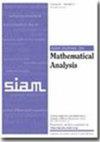Resolvent Estimates for Viscoelastic Systems of Extended Maxwell Type and Their Applications
IF 1.9
2区 数学
Q1 MATHEMATICS, APPLIED
引用次数: 0
Abstract
SIAM Journal on Mathematical Analysis, Volume 56, Issue 5, Page 5782-5806, October 2024.Abstract. In the theory of viscoelasticity, an important class of models admits a representation in terms of springs and dashpots. Widely used members of this class are the Maxwell model and its extended version. This paper concerns resolvent estimates for the system of equations for the anisotropic, extended Maxwell model (EMM) and its marginal model; special attention is paid to the introduction of augmented variables. This leads to the augmented system that will also be referred to as the “original” system. A reduced system is then formed which encodes essentially the EMM; it is a closed system with respect to the particle velocity and the difference between the elastic and viscous strains. Based on resolvent estimates, it is shown that the original and reduced systems generate [math]-groups and the reduced system generates a [math]-semigroup of contraction. Naturally, the EMM can be written in an integro-differential form with a relaxation tensor. However, there is a difference between the original and integro-differential systems, in general, with consequences for whether their solutions generate semigroups or not. Finally, an energy estimate is obtained for the reduced system, and it is proven that its solutions decay exponentially as time tends to infinity. The limiting amplitude principle follows readily from these two results.
扩展麦克斯韦类型粘弹性系统的残差估计及其应用
SIAM 数学分析期刊》,第 56 卷,第 5 期,第 5782-5806 页,2024 年 10 月。 摘要。在粘弹性理论中,有一类重要的模型可以用弹簧和冲刺点来表示。这类模型中广泛使用的是麦克斯韦模型及其扩展版。本文涉及各向异性的扩展麦克斯韦模型(EMM)及其边际模型方程组的解析估算;特别关注了增强变量的引入。这导致了增强系统,也将被称为 "原始 "系统。然后形成一个简化系统,该系统基本编码了 EMM;它是一个与粒子速度以及弹性应变和粘性应变之差有关的封闭系统。根据解析估算,原始系统和还原系统会产生[math]群,而还原系统会产生[math]收缩半群。自然,EMM 可以用松弛张量的积分微分形式来写。然而,原始系统与积分微分系统之间一般存在差异,这对它们的解是否产生半群有影响。最后,我们得到了还原系统的能量估计值,并证明其解随着时间趋于无穷大而呈指数衰减。从这两个结果很容易得出极限振幅原理。
本文章由计算机程序翻译,如有差异,请以英文原文为准。
求助全文
约1分钟内获得全文
求助全文
来源期刊
CiteScore
3.30
自引率
5.00%
发文量
175
审稿时长
12 months
期刊介绍:
SIAM Journal on Mathematical Analysis (SIMA) features research articles of the highest quality employing innovative analytical techniques to treat problems in the natural sciences. Every paper has content that is primarily analytical and that employs mathematical methods in such areas as partial differential equations, the calculus of variations, functional analysis, approximation theory, harmonic or wavelet analysis, or dynamical systems. Additionally, every paper relates to a model for natural phenomena in such areas as fluid mechanics, materials science, quantum mechanics, biology, mathematical physics, or to the computational analysis of such phenomena.
Submission of a manuscript to a SIAM journal is representation by the author that the manuscript has not been published or submitted simultaneously for publication elsewhere.
Typical papers for SIMA do not exceed 35 journal pages. Substantial deviations from this page limit require that the referees, editor, and editor-in-chief be convinced that the increased length is both required by the subject matter and justified by the quality of the paper.

 求助内容:
求助内容: 应助结果提醒方式:
应助结果提醒方式:


